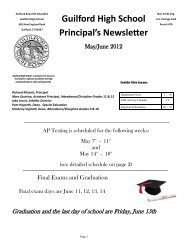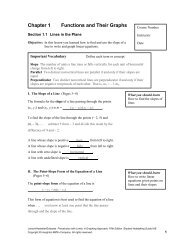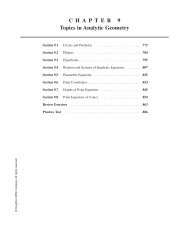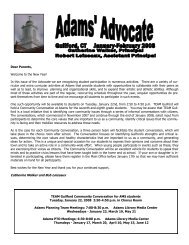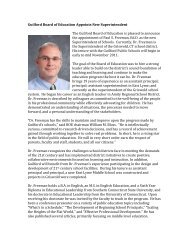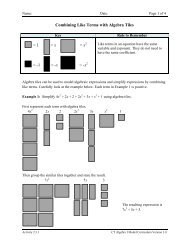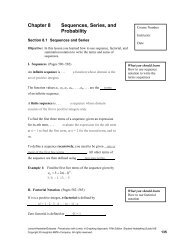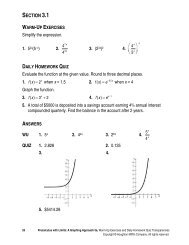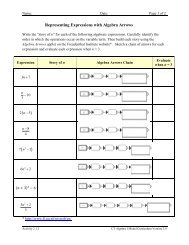Chapter 9 Review Name________________________ 1. What of ...
Chapter 9 Review Name________________________ 1. What of ...
Chapter 9 Review Name________________________ 1. What of ...
You also want an ePaper? Increase the reach of your titles
YUMPU automatically turns print PDFs into web optimized ePapers that Google loves.
<strong>Chapter</strong> 9 <strong>Review</strong><br />
<strong>Name</strong>________________________<br />
<strong>1.</strong> <strong>What</strong> <strong>of</strong> the following best describes a sampling distribution <strong>of</strong> a statistic?<br />
a. It is the probability that the sample statistic equals the parameter <strong>of</strong><br />
interest.<br />
b. It is the probability distribution <strong>of</strong> all the values that are contained in all<br />
possible samples <strong>of</strong> the same size.<br />
c. It is the distribution <strong>of</strong> all <strong>of</strong> the statistics calculated from all possible<br />
samples <strong>of</strong> the same size.<br />
d. It is the histogram <strong>of</strong> sample statistics from all possible samples <strong>of</strong> the<br />
same size.<br />
e. It is none <strong>of</strong> these.<br />
2. A simple random sample <strong>of</strong> 50 adults was asked to reveal their gross annual<br />
incomes. The variance <strong>of</strong> this sample:<br />
a. is always smaller than the variance <strong>of</strong> the population.<br />
b. cannot be computed since the population size is not given.<br />
c. equals the variance <strong>of</strong> the population.<br />
d. is an estimate <strong>of</strong> the variance in the sampling distribution <strong>of</strong> the means <strong>of</strong><br />
the gross annual incomes <strong>of</strong> all possible samples.<br />
e. is an estimate <strong>of</strong> the variance <strong>of</strong> the population but may differ from the<br />
variance <strong>of</strong> the population.<br />
3. A simple random sample <strong>of</strong> 100 high school seniors in a certain suburb reveals<br />
that 65% <strong>of</strong> them have at least part-time jobs in addition to school. If the<br />
expected value <strong>of</strong> this proportion is equal to the proportion <strong>of</strong> high school seniors<br />
who have at least part-time jobs for the entire suburb, then we say that the sample<br />
proportion is:<br />
a. A true value<br />
b. An unbiased estimator <strong>of</strong> the population proportion.<br />
c. Equal to the population proportion<br />
d. An estimate <strong>of</strong> whose variance equals the variance <strong>of</strong> data in the<br />
population<br />
e. Less than the population proportion since only 100 students were sampled.<br />
Use the following information for questions 4 and 5. Suppose you roll a die 10 times and<br />
record the proportion <strong>of</strong> sixes. Suppose you then conduct a simulation <strong>of</strong> this<br />
experiment, first 100 times, then 1,000 times, and draw one histogram <strong>of</strong> the proportion<br />
<strong>of</strong> sixes found after 100 simulations and a second histogram <strong>of</strong> the proportions <strong>of</strong> sixes<br />
found after 1,000 simulations.<br />
4. Which <strong>of</strong> the following is true regarding the mean <strong>of</strong> the proportions <strong>of</strong> sixes from<br />
each simulation?<br />
a. The mean <strong>of</strong> the proportion <strong>of</strong> sixes for the 100 simulations will be more<br />
than the mean <strong>of</strong> the proportion <strong>of</strong> sixes for the 1,000 simulations.<br />
b. The mean <strong>of</strong> the proportion <strong>of</strong> sixes for the 1,000 simulations will be a<br />
better estimator <strong>of</strong> the theoretical probability <strong>of</strong> rolling a six than the mean<br />
<strong>of</strong> the proportion <strong>of</strong> sixes for the 100 simulations.
A.P. Statistics<br />
Mr. Johnson<br />
c. The mean <strong>of</strong> the proportion <strong>of</strong> sixes for the 100 simulations will be less<br />
than the mean <strong>of</strong> the proportion <strong>of</strong> sixes for the 1,000 simulations.<br />
d. The mean <strong>of</strong> the proportion <strong>of</strong> sixes for both simulations will not estimate<br />
the theoretical probability <strong>of</strong> rolling a six since they are finite samples<br />
from an infinite population.<br />
e. None <strong>of</strong> these is true.<br />
5. Which <strong>of</strong> the following statements are true regarding the histograms <strong>of</strong> the results<br />
form the two simulations?<br />
I. The histograms from both simulations will be skewed left<br />
since a fair die does not exist in nature.<br />
II.<br />
The histograms from both simulations will be mound-shaped<br />
and symmetric.<br />
III. The histogram from the experiment that has 1,000<br />
simulations will tend to be more mound-shaped and<br />
symmetric than the histogram from the experiment that has<br />
100 simulations.<br />
a. I only<br />
b. I and II<br />
c. II and III<br />
d. III only<br />
e. None <strong>of</strong> these statements is true.<br />
6. Two simple random samples <strong>of</strong> 50 undergraduates each from two universities are<br />
taken to determine the proportion <strong>of</strong> students who approve <strong>of</strong> the food service at<br />
their respective schools. The first university has an enrollment <strong>of</strong> 5,000<br />
undergraduates while the second university has an enrollment <strong>of</strong> 35,000<br />
undergraduates. Which <strong>of</strong> the following is the most accurate statement regarding<br />
these samples?<br />
a. The variability <strong>of</strong> the sample from the larger university will be greater<br />
than the variability <strong>of</strong> the sample from the smaller university.<br />
b. The proportion <strong>of</strong> students who approve <strong>of</strong> the food service will be the<br />
same since the sample sizes are the same.<br />
c. The enrollment figures from the two universities are not relevant to<br />
whether the sample statistics obtained are unbiased estimates <strong>of</strong> the<br />
parameters <strong>of</strong> the two populations.<br />
d. If a university with 100,000 undergraduates conducted a simple random<br />
sample <strong>of</strong> 50 <strong>of</strong> its students, the results would be less accurate than either<br />
sample referenced above.<br />
e. None <strong>of</strong> these is an accurate statement.<br />
7. Which <strong>of</strong> the following is true regarding the variation <strong>of</strong> a sampling distribution<br />
<strong>of</strong> a sample proportion?<br />
a. Variation depends on population size as well as sample size.<br />
b. The variance <strong>of</strong> a sampling distribution <strong>of</strong> a sample proportion for all<br />
samples <strong>of</strong> size 1 is 0.<br />
<strong>Chapter</strong> 9 2 <strong>Review</strong>
A.P. Statistics<br />
Mr. Johnson<br />
c. As the size <strong>of</strong> the sample increases, the variation <strong>of</strong> the sampling<br />
distribution approaches the variation <strong>of</strong> the population.<br />
d. For a given sample size, the maximum variation in the sampling<br />
distribution <strong>of</strong> a population proportion occurs when the sample proportion<br />
is 0.5.<br />
e. None <strong>of</strong> these is true.<br />
8. The conditions that np > 10 and n(1 – p) > 10 are tested for a sampling<br />
distribution to check for<br />
a. A sample that is not representative <strong>of</strong> the population.<br />
b. Bias in the response <strong>of</strong> the sample participants.<br />
c. Skewness in the distribution.<br />
d. A very small population size.<br />
e. The conditions are designed to check for any <strong>of</strong> these conditions.<br />
9. Records at a large university indicated that 20% <strong>of</strong> all freshmen are placed on<br />
academic probation at the end <strong>of</strong> the first semester. A random sample <strong>of</strong> 100 <strong>of</strong><br />
this year’s freshmen indicated that 25% <strong>of</strong> them were placed on academic<br />
probation at the end <strong>of</strong> the first semester. The results <strong>of</strong> this sample:<br />
a. Are surprising since it indicates that 5% more <strong>of</strong> these freshmen were<br />
placed on academic probation than was expected.<br />
b. Are surprising since SAT scores have been increasing over the past few<br />
years.<br />
c. Are not surprising since the standard deviation <strong>of</strong> the sampling distribution<br />
is 4%.<br />
d. Are surprising since the standard deviation <strong>of</strong> the sampling distribution is<br />
.4%.<br />
e. Are biased since the increase <strong>of</strong> 5% could not happen without injecting<br />
bias into the sample.<br />
10. An investigator anticipates that the proportion <strong>of</strong> red blossoms in his hybrid plants<br />
is .15. A random sample <strong>of</strong> 50 <strong>of</strong> his plants indicated that 22% <strong>of</strong> the blossoms<br />
were red. Assuming that the proportion <strong>of</strong> red blossoms is .15, the standard<br />
deviation <strong>of</strong> the sampling distribution <strong>of</strong> the sample proportion is approximately:<br />
a. .051<br />
b. .059<br />
c. .07<br />
d. .116<br />
e. Cannot be determined<br />
1<strong>1.</strong> A sample <strong>of</strong> size 49 is drawn from a normal population with mean <strong>of</strong> 63 and<br />
standard deviation <strong>of</strong> 14. <strong>What</strong> are the mean and standard deviation <strong>of</strong> the<br />
distribution <strong>of</strong> sample means?<br />
a. μ = 9, σ = 2<br />
b. μ = 63, σ = .268<br />
c. μ = 63, σ = 2<br />
<strong>Chapter</strong> 9 3 <strong>Review</strong>
A.P. Statistics<br />
Mr. Johnson<br />
d. μ = <strong>1.</strong>286, σ = 3.5<br />
e. μ = 9, σ = 14<br />
12. A sample <strong>of</strong> size 24 is drawn from a normal population with mean <strong>of</strong> 62. If the<br />
standard deviation <strong>of</strong> the sample means is 3.5, what is the standard deviation <strong>of</strong><br />
the original population?<br />
a. .056<br />
b. .408<br />
c. 2.48<br />
d. 17.5<br />
e. 87.5<br />
13. The distribution <strong>of</strong> SAT Math scores <strong>of</strong> students taking Calculus I at a large<br />
university is skewed left with mean 624 and standard deviation 44.5. If random<br />
samples <strong>of</strong> 100 students are repeatedly taken, which statement best describes the<br />
sampling distribution <strong>of</strong> sample means?<br />
a. Normal with mean 625 and standard deviation 44.5.<br />
b. Normal with mean 625 and standard deviation 4.45.<br />
c. Shape unknown with mean 625 and standard deviation 44.5.<br />
d. Shape unknown with mean 625 and standard deviation 4.45.<br />
e. No conclusions can be drawn since the population is not normally<br />
distributed.<br />
14. Which <strong>of</strong> the following statements regarding the sampling distribution <strong>of</strong> sample<br />
means is incorrect?<br />
a. The sampling distribution is approximately normal when the population is<br />
normal or the sample size is sufficiently large.<br />
b. The mean <strong>of</strong> the sampling distribution is the mean <strong>of</strong> the population.<br />
c. The standard deviation <strong>of</strong> the sampling distribution is the standard<br />
deviation <strong>of</strong> the population.<br />
d. The sampling distribution is found by taking repeated samples <strong>of</strong> the same<br />
size from the population <strong>of</strong> interest and computing the mean <strong>of</strong> each<br />
sample.<br />
e. All <strong>of</strong> these are correct.<br />
15. After repeated observations, it has been determined that the waiting time at the<br />
drive-through window at a local bank on Friday afternoons between 12:00 and<br />
6:00 PM is skewed left with a mean <strong>of</strong> 3.5 minutes and a standard deviation <strong>of</strong> <strong>1.</strong>9<br />
minutes. A sample <strong>of</strong> 100 customers is to be taken next Friday. <strong>What</strong> is the<br />
probability that the mean <strong>of</strong> the sample will exceed 4 minutes?<br />
a. .0042<br />
b. .0369<br />
c. .042<br />
d. .396<br />
e. The probability cannot be determined using a normal curve<br />
approximation.<br />
<strong>Chapter</strong> 9 4 <strong>Review</strong>
A.P. Statistics<br />
Mr. Johnson<br />
<strong>1.</strong> Suppose that 47% <strong>of</strong> all adult women think they do not get enough time to<br />
themselves. An opinion poll interviews 1025 randomly selected women and<br />
records the sample proportion that do not think they get enough time to<br />
themselves.<br />
a. Describe the sampling distribution <strong>of</strong> pˆ .<br />
b. The truth about the population is that p = 0.47. In what range will the<br />
middle 95% <strong>of</strong> all sample results fall?<br />
c. <strong>What</strong> is the probability that the poll gets a sample in which fewer than<br />
45% <strong>of</strong> women say they don’t get enough time to themselves?<br />
<strong>Chapter</strong> 9 5 <strong>Review</strong>
A.P. Statistics<br />
Mr. Johnson<br />
2. The Wechsler Adult Intelligence Scale (WAIS) is a common “IQ” test for adults.<br />
The distribution <strong>of</strong> WAIS scores for persons over 16 is approximately Normal<br />
with mean 100 and standard deviation 15.<br />
a. <strong>What</strong> is the probability that a randomly chosen individual has a score over<br />
105?<br />
b. <strong>What</strong> is the probability that the average IQ from an SRS <strong>of</strong> 60 adults is<br />
105 or higher?<br />
c. Would your answers be different if the distribution <strong>of</strong> WAIS scores was<br />
distinctly nonnormal? Explain why or why not.<br />
<strong>Chapter</strong> 9 6 <strong>Review</strong>




